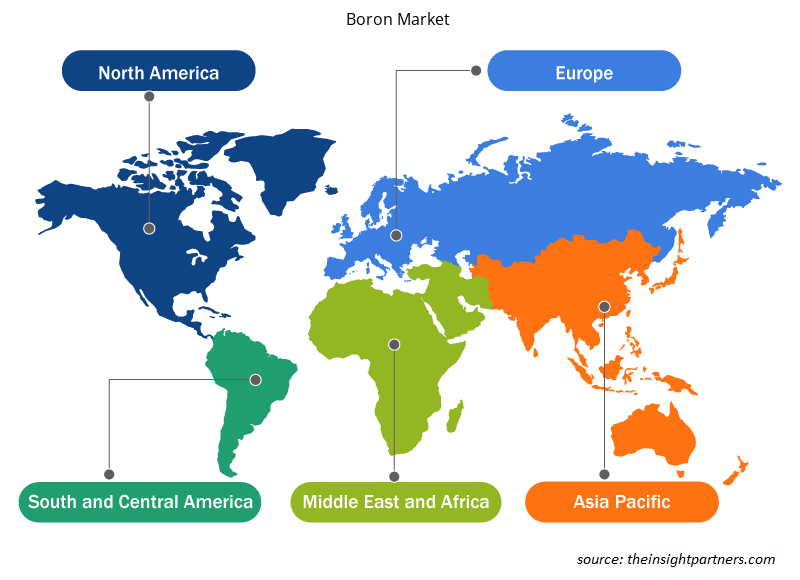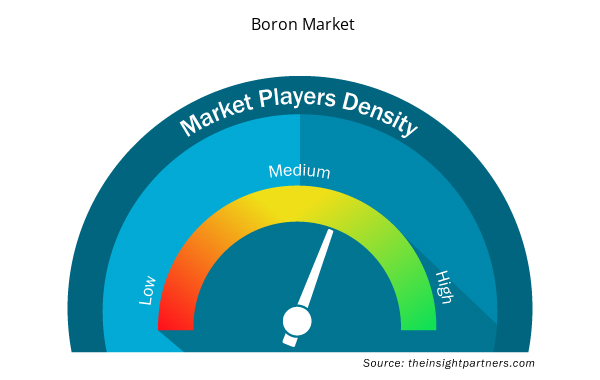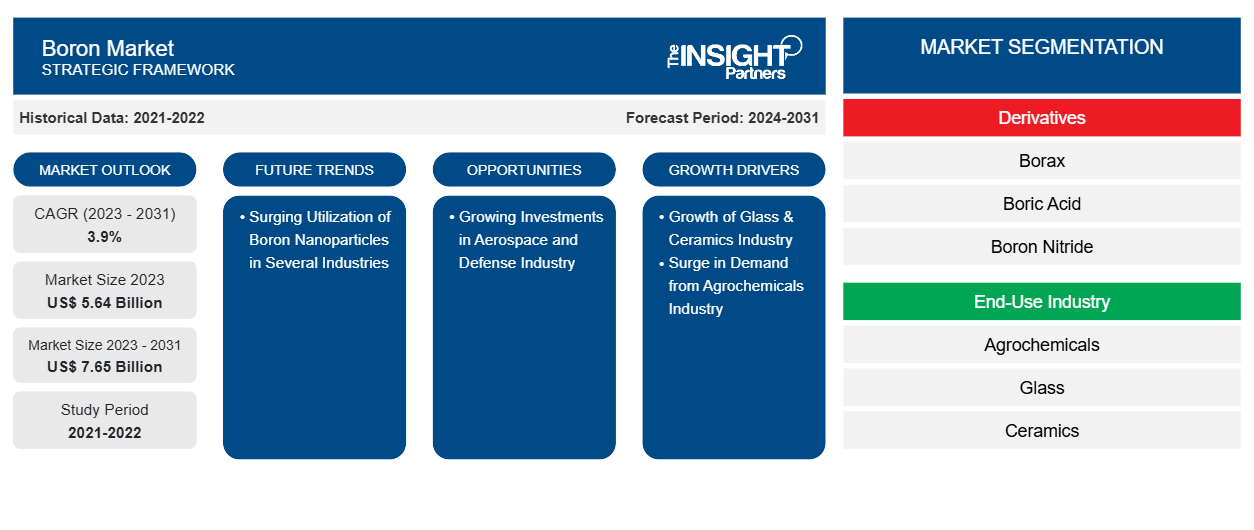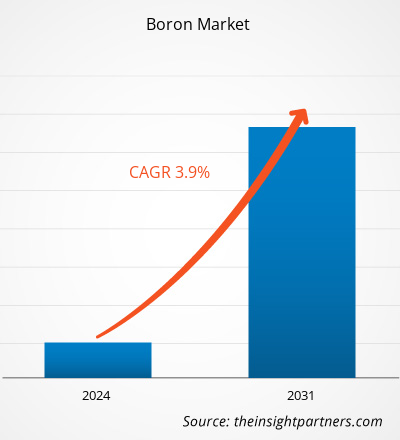Der Markt für Bor soll von 5,64 Milliarden US-Dollar im Jahr 2023 auf 7,65 Milliarden US-Dollar im Jahr 2031 anwachsen. Für den Zeitraum 2023–2031 wird ein durchschnittliches jährliches Wachstum von 3,9 % erwartet. Die Ausweitung der Boranwendungen in der Glas- und Keramik- sowie der Agrochemieindustrie dürfte einer der wichtigsten Trends auf dem Markt bleiben.
Bor-Marktanalyse
Boroxid wird in der Glasindustrie zur Herstellung von Borosilikatglas verwendet , das für seine geringe Wärmeausdehnung bekannt ist. Bornitrid ist ein fortschrittliches keramisches Material, das synthetisch hergestellt und in Pulverform erhältlich ist. Es bietet Wärmeleitfähigkeit und Temperaturschockbeständigkeit. Bor ist ein wichtiger Mikronährstoff mit einem breiten Anwendungsbereich in der Agrochemieindustrie , da es das Wachstum und die Gesundheit von Pflanzen fördert. Im Jahr 2023 investierte Markab Capital 180 Millionen US-Dollar in den Bau einer Produktionsanlage für Zivilflugzeuge in den VAE , indem es eine Vereinbarung mit Super Jet International unterzeichnete. Die erste Produktionsphase umfasste eine jährliche Produktionskapazität von 10–15 Flugzeugen. Solche Investitionen in die Entwicklung leichter Flugzeugstrukturen dürften den Marktteilnehmern in den kommenden Jahren zahlreiche Chancen eröffnen.
Bor Marktübersicht
Borate sind natürlich vorkommende Mineralien, die Bor enthalten und mehrere wichtige Eigenschaften wie metabolisierende, bleichende, puffernde, dispergierende und verglasende Eigenschaften besitzen. Der Borabbau umfasst eine Reihe von Schritten zur Extraktion kostengünstiger und hochwertiger Mineralien. Borderivate wie Borax, Borsäure , Borcarbid und Boroxid werden in mehreren Endverbrauchsbranchen eingesetzt. Borsäure oder Borwasserstoff wird in Antiseptika, Insektiziden, Flammschutzmitteln, Glas und Keramik verwendet. Seine Eigenschaften verbessern die Haltbarkeit, Hitzebeständigkeit und Klarheit von Glas und Keramik. Düngemittelhersteller mischen Bor in Produkte, um die Ernteerträge zu verbessern. Borverbindungen werden aufgrund ihrer aufhellenden und fleckenentfernenden Eigenschaften bei der Herstellung von Haushalts- und Industriereinigungsprodukten verwendet. Borax kommt auf natürliche Weise in Evaporitvorkommen vor , die sowohl über- als auch untertägigem Bergbau gewonnen werden.
Passen Sie diesen Bericht Ihren Anforderungen an
Sie erhalten kostenlose Anpassungen an jedem Bericht, einschließlich Teilen dieses Berichts oder einer Analyse auf Länderebene, eines Excel-Datenpakets sowie tolle Angebote und Rabatte für Start-ups und Universitäten.
- Holen Sie sich die wichtigsten Markttrends aus diesem Bericht.Dieses KOSTENLOSE Beispiel umfasst eine Datenanalyse von Markttrends bis hin zu Schätzungen und Prognosen.
Treiber und Chancen auf dem Bormarkt
Schnelles Wachstum der Glas- und Keramikindustrie
Borate werden zur Isolierung von Glasfasern verwendet, während Glaswolle 4–7 % Borate enthält. Darüber hinaus wird Boroxid zur Herstellung hochwertiger handgefertigter Dekorationsartikel verwendet. Ein Cäsium- Borosilikatglas wird verwendet, um Solarzellen auf Satelliten vor der schädlichen Strahlung im Weltraum zu schützen. Die rasante Entwicklung von Dünnschichttransistor-Flüssigkristallanzeigen ( TFT- LCD) wurde durch die Verwendung spezieller Borosilikatgläser beschleunigt . Borate werden zur Herstellung versiegelter Scheinwerfer, Lampenabdeckungen, Halogenlampen und Leuchtstoffröhren verwendet, die auf hohen elektrischen Widerstand, Festigkeit, chemische Beständigkeit und Temperaturwechselbeständigkeit ausgelegt sind. Somit ist das Wachstum der Glas- und Keramikindustrie einer der Haupttreiber des Bormarktes.
Wachsende Investitionen in der Luft- und Raumfahrt- und Verteidigungsindustrie
Borfasern und Borcarbid sind hochfeste und leichte Materialien, die in Luft- und Raumfahrtstrukturen verwendet werden. Der zunehmende Einsatz von Leichtbaumaterialien in der Luft- und Raumfahrt- und Verteidigungsindustrie treibt die Nachfrage nach Bor an. Borverbindungen wie Bornitrid können hohen Temperaturen standhalten und werden daher in Hitzeschilden, Wärmeschutzsystemen und anderen Hochtemperaturanwendungen eingesetzt. Bor wird als Dotierstoff in Halbleitern verwendet, um die Eigenschaften hochentwickelter Elektronik zu verbessern, die in der Luft- und Raumfahrt- und Verteidigungsindustrie eingesetzt wird. Die Luft- und Raumfahrtindustrie in Kanada produziert mit staatlicher Förderung in erheblichem Umfang Flugzeugkomponenten für den kommerziellen Einsatz. Laut dem Bericht der International Trade Association hat die kanadische Regierung den Luft- und Raumfahrtsektor im Zeitraum 2021–2022 über den Federal Strategic Innovation Fund mit 1,36 Milliarden US-Dollar unterstützt. Daher wird erwartet, dass die steigenden Investitionen in die Luft- und Raumfahrt- und Verteidigungsindustrie im Prognosezeitraum lukrative Möglichkeiten für das Wachstum des Bormarktes schaffen werden.
Segmentierungsanalyse des Bor-Marktberichts
Wichtige Segmente, die zur Ableitung der Bor-Marktanalyse beigetragen haben, sind Derivate und die Endverbrauchsindustrie.
- Basierend auf Derivaten ist der Bormarkt in Borax, Borsäure, Bornitrid, Borcarbid, Boroxid und andere unterteilt. Das Segment Bornitrid hatte im Jahr 2023 den größten Marktanteil.
- In Bezug auf die Endverbrauchsindustrie wird der Markt in Agrochemikalien, Glas, Keramik, Reinigungsmittel, Pharmazeutika, Elektrik und Elektronik und andere unterteilt. Das Glassegment hielt im Jahr 2023 einen bedeutenden Marktanteil.
Bor Marktanteilsanalyse nach Geografie
Der geografische Umfang des Bor-Marktberichts ist hauptsächlich in fünf Regionen unterteilt: Nordamerika, Asien-Pazifik, Europa, Naher Osten und Afrika sowie Süd- und Mittelamerika.
Im Jahr 2023 dominierte Europa den Markt für Bor. Die Glasindustrie ist eine der größten Fertigungsindustrien in Europa. Nach Angaben der Europäischen Kommission ist Europa der weltweit größte Glasproduzent mit einem Marktanteil von etwa einem Drittel der gesamten Weltproduktion. Europa ist ein vielfältiger Markt mit mehreren entwickelten und sich entwickelnden Volkswirtschaften wie Deutschland, Frankreich, Italien, Großbritannien, Spanien und Russland. In der Region gibt es mehrere große Glashersteller wie Saint-Gobain, Schott und AGC Inc. Die Hersteller sind an der strategischen Expansion und Produktentwicklung beteiligt, um die steigende Nachfrage nach Glas aus den Endverbrauchsindustrien zu decken. So investierte AGC Inc. im Februar 2022 etwa 10,57 Millionen US-Dollar in seine Laminieranlage, die in seinem Werk in Osterweddingen (Deutschland) installiert werden soll.
Europa ist für seine Arzneimittelproduktion bekannt. Deutschland, Frankreich, die Schweiz und Italien sind die größten Produzenten der Region. In der Pharmaindustrie wird Bor in Augenpflegeprodukten verwendet, da Bor Feuchtigkeit speichert, den pH-Wert reguliert und Reizstoffe lindert. Daher fördert der steigende Verbrauch von Bor in verschiedenen Branchen, wie erneuerbare Energien, Glas und Keramik sowie Pharmazeutika, das Wachstum des Bormarktes in Europa.
Regionale Einblicke in den Bormarkt
Die regionalen Trends und Faktoren, die den Bormarkt während des Prognosezeitraums beeinflussen, wurden von den Analysten von Insight Partners ausführlich erläutert. In diesem Abschnitt werden auch Bormarktsegmente und -geografie in Nordamerika, Europa, im asiatisch-pazifischen Raum, im Nahen Osten und Afrika sowie in Süd- und Mittelamerika erörtert.

- Erhalten Sie regionalspezifische Daten zum Bormarkt
Umfang des Bor-Marktberichts
| Berichtsattribut | Details |
|---|---|
| Marktgröße im Jahr 2023 | 5,64 Milliarden US-Dollar |
| Marktgröße bis 2031 | 7,65 Milliarden US-Dollar |
| Globale CAGR (2023 - 2031) | 3,9 % |
| Historische Daten | 2021-2022 |
| Prognosezeitraum | 2024–2031 |
| Abgedeckte Segmente | Nach Derivaten
|
| Abgedeckte Regionen und Länder | Nordamerika
|
| Marktführer und wichtige Unternehmensprofile |
|
Marktteilnehmerdichte: Der Einfluss auf die Geschäftsdynamik
Der Bormarkt wächst rasant, angetrieben durch die steigende Endverbrauchernachfrage aufgrund von Faktoren wie sich entwickelnden Verbraucherpräferenzen, technologischen Fortschritten und einem größeren Bewusstsein für die Vorteile des Produkts. Mit steigender Nachfrage erweitern Unternehmen ihr Angebot, entwickeln Innovationen, um die Bedürfnisse der Verbraucher zu erfüllen, und nutzen neue Trends, was das Marktwachstum weiter ankurbelt.
Die Marktteilnehmerdichte bezieht sich auf die Verteilung von Firmen oder Unternehmen, die in einem bestimmten Markt oder einer bestimmten Branche tätig sind. Sie gibt an, wie viele Wettbewerber (Marktteilnehmer) in einem bestimmten Marktraum im Verhältnis zu seiner Größe oder seinem gesamten Marktwert präsent sind.
Die wichtigsten auf dem Bormarkt tätigen Unternehmen sind:
- Nippon Denko Co., Ltd
- Hoganas AB
- 3M Co
- Ube Corporation
- Arkema SA
- JFE Mineral & Alloy Co Ltd
Haftungsausschluss : Die oben aufgeführten Unternehmen sind nicht in einer bestimmten Reihenfolge aufgeführt.

- Überblick über die wichtigsten Akteure auf dem Bormarkt
Neuigkeiten und aktuelle Entwicklungen zum Bormarkt
Der Bormarkt wird durch die Erhebung qualitativer und quantitativer Daten aus Primär- und Sekundärforschung bewertet, die wichtige Unternehmensveröffentlichungen, Verbandsdaten und Datenbanken einschließen. Nachfolgend sind einige der Entwicklungen auf dem Bormarkt aufgeführt:
- 5E Advanced Materials, Inc. gab den Start der kommerziellen Produktion von Borsäure im 5E Boron America's Complex bekannt. (Quelle: 5E Advanced Materials/Pressemitteilung/April 2024)
- Compagnie de Saint Gobain SA kündigte eine neue Linie pigmentierter Bornitrid-Beschichtungen an, CeraGlide Azure. (Quelle: Compagnie de Saint Gobain SA/Pressemitteilung/November 2023)
- Compagnie de Saint Gobain SA hat in Zusammenarbeit mit der Haydale Group eine Kooperationsvereinbarung zur Entwicklung fortschrittlicher Oberflächenchemie für Bornitridpulver geschlossen. (Quelle: Compagnie de Saint Gobain SA/Pressemitteilung/September 2023)
Abdeckung und Ergebnisse des Bor-Marktberichts
Der Bericht „Marktgröße und Prognose für Bor (2021–2031)“ bietet eine detaillierte Analyse des Marktes, die die folgenden Bereiche abdeckt:
- Bor-Marktgröße und -prognose auf globaler, regionaler und Länderebene für alle wichtigen Marktsegmente, die im Rahmen des Berichts abgedeckt sind
- Bor-Markttrends sowie Marktdynamik wie Treiber, Beschränkungen und wichtige Chancen
- Detaillierte Porter's Five Forces Analyse und SWOT-Analyse
- Bor-Marktanalyse mit wichtigen Markttrends, globalen und regionalen Rahmenbedingungen, wichtigen Akteuren, Vorschriften und aktuellen Marktentwicklungen
- Branchenlandschaft und Wettbewerbsanalyse mit Marktkonzentration, Heatmap-Analyse, prominenten Akteuren und aktuellen Entwicklungen auf dem Bormarkt
- Detaillierte Firmenprofile
- Historische Analyse (2 Jahre), Basisjahr, Prognose (7 Jahre) mit CAGR
- PEST- und SWOT-Analyse
- Marktgröße Wert/Volumen – Global, Regional, Land
- Branche und Wettbewerbsumfeld
- Excel-Datensatz


- Medical Devices Market
- Visualization and 3D Rendering Software Market
- Lymphedema Treatment Market
- Cell Line Development Market
- Authentication and Brand Protection Market
- Biopharmaceutical Contract Manufacturing Market
- Trade Promotion Management Software Market
- Vaginal Specula Market
- Clear Aligners Market
- Bioremediation Technology and Services Market

Report Coverage
Revenue forecast, Company Analysis, Industry landscape, Growth factors, and Trends

Segment Covered
This text is related
to segments covered.

Regional Scope
North America, Europe, Asia Pacific, Middle East & Africa, South & Central America

Country Scope
This text is related
to country scope.
Häufig gestellte Fragen
Europe dominated the boron market in 2023.
Growth in the glass & ceramics industry and surging demand from the agrochemicals industry are a few driving factors of the boron market.
The future trends of the boron market include increasing utilization of boron nanoparticles across several end-use industries.
Nippon Denko Co Ltd, Hoganas AB, Compagnie de Saint Gobain SA, Rio Tinto Ltd, and Arkema SA are the leading players operating in the boron market.
The boron market value is estimated to be US$ 7.65 billion by 2031.
The boron market is expected to register a CAGR of 3.9% during 2023–2031.
Trends and growth analysis reports related to Chemicals and Materials : READ MORE..
The List of Companies - Boron Market
- Rio Tinto Group
- AbEti Products Oy
- Hoganas AB
- Nippon Denko Co Ltd
- Compagnie de Saint Gobain SA
- 3M Co
- Stella Chemifa Corp
- UBE Corp
- Boron Specialties LLC
- JFE Mineral & Alloy Co Ltd
- Arkema SA
- Tokyo Chemical Industry Co Ltd
- FREEMAN (JAPAN) CO., LTD.
- KROSAKI HARIMA CORPORATION
- Washington Mills Electro Minerals Limited
The Insight Partners performs research in 4 major stages: Data Collection & Secondary Research, Primary Research, Data Analysis and Data Triangulation & Final Review.
- Data Collection and Secondary Research:
As a market research and consulting firm operating from a decade, we have published and advised several client across the globe. First step for any study will start with an assessment of currently available data and insights from existing reports. Further, historical and current market information is collected from Investor Presentations, Annual Reports, SEC Filings, etc., and other information related to company’s performance and market positioning are gathered from Paid Databases (Factiva, Hoovers, and Reuters) and various other publications available in public domain.
Several associations trade associates, technical forums, institutes, societies and organization are accessed to gain technical as well as market related insights through their publications such as research papers, blogs and press releases related to the studies are referred to get cues about the market. Further, white papers, journals, magazines, and other news articles published in last 3 years are scrutinized and analyzed to understand the current market trends.
- Primary Research:
The primarily interview analysis comprise of data obtained from industry participants interview and answers to survey questions gathered by in-house primary team.
For primary research, interviews are conducted with industry experts/CEOs/Marketing Managers/VPs/Subject Matter Experts from both demand and supply side to get a 360-degree view of the market. The primary team conducts several interviews based on the complexity of the markets to understand the various market trends and dynamics which makes research more credible and precise.
A typical research interview fulfils the following functions:
- Provides first-hand information on the market size, market trends, growth trends, competitive landscape, and outlook
- Validates and strengthens in-house secondary research findings
- Develops the analysis team’s expertise and market understanding
Primary research involves email interactions and telephone interviews for each market, category, segment, and sub-segment across geographies. The participants who typically take part in such a process include, but are not limited to:
- Industry participants: VPs, business development managers, market intelligence managers and national sales managers
- Outside experts: Valuation experts, research analysts and key opinion leaders specializing in the electronics and semiconductor industry.
Below is the breakup of our primary respondents by company, designation, and region:

Once we receive the confirmation from primary research sources or primary respondents, we finalize the base year market estimation and forecast the data as per the macroeconomic and microeconomic factors assessed during data collection.
- Data Analysis:
Once data is validated through both secondary as well as primary respondents, we finalize the market estimations by hypothesis formulation and factor analysis at regional and country level.
- Macro-Economic Factor Analysis:
We analyse macroeconomic indicators such the gross domestic product (GDP), increase in the demand for goods and services across industries, technological advancement, regional economic growth, governmental policies, the influence of COVID-19, PEST analysis, and other aspects. This analysis aids in setting benchmarks for various nations/regions and approximating market splits. Additionally, the general trend of the aforementioned components aid in determining the market's development possibilities.
- Country Level Data:
Various factors that are especially aligned to the country are taken into account to determine the market size for a certain area and country, including the presence of vendors, such as headquarters and offices, the country's GDP, demand patterns, and industry growth. To comprehend the market dynamics for the nation, a number of growth variables, inhibitors, application areas, and current market trends are researched. The aforementioned elements aid in determining the country's overall market's growth potential.
- Company Profile:
The “Table of Contents” is formulated by listing and analyzing more than 25 - 30 companies operating in the market ecosystem across geographies. However, we profile only 10 companies as a standard practice in our syndicate reports. These 10 companies comprise leading, emerging, and regional players. Nonetheless, our analysis is not restricted to the 10 listed companies, we also analyze other companies present in the market to develop a holistic view and understand the prevailing trends. The “Company Profiles” section in the report covers key facts, business description, products & services, financial information, SWOT analysis, and key developments. The financial information presented is extracted from the annual reports and official documents of the publicly listed companies. Upon collecting the information for the sections of respective companies, we verify them via various primary sources and then compile the data in respective company profiles. The company level information helps us in deriving the base number as well as in forecasting the market size.
- Developing Base Number:
Aggregation of sales statistics (2020-2022) and macro-economic factor, and other secondary and primary research insights are utilized to arrive at base number and related market shares for 2022. The data gaps are identified in this step and relevant market data is analyzed, collected from paid primary interviews or databases. On finalizing the base year market size, forecasts are developed on the basis of macro-economic, industry and market growth factors and company level analysis.
- Data Triangulation and Final Review:
The market findings and base year market size calculations are validated from supply as well as demand side. Demand side validations are based on macro-economic factor analysis and benchmarks for respective regions and countries. In case of supply side validations, revenues of major companies are estimated (in case not available) based on industry benchmark, approximate number of employees, product portfolio, and primary interviews revenues are gathered. Further revenue from target product/service segment is assessed to avoid overshooting of market statistics. In case of heavy deviations between supply and demand side values, all thes steps are repeated to achieve synchronization.
We follow an iterative model, wherein we share our research findings with Subject Matter Experts (SME’s) and Key Opinion Leaders (KOLs) until consensus view of the market is not formulated – this model negates any drastic deviation in the opinions of experts. Only validated and universally acceptable research findings are quoted in our reports.
We have important check points that we use to validate our research findings – which we call – data triangulation, where we validate the information, we generate from secondary sources with primary interviews and then we re-validate with our internal data bases and Subject matter experts. This comprehensive model enables us to deliver high quality, reliable data in shortest possible time.


 Holen Sie sich ein kostenloses Muster für diesen Bericht
Holen Sie sich ein kostenloses Muster für diesen Bericht